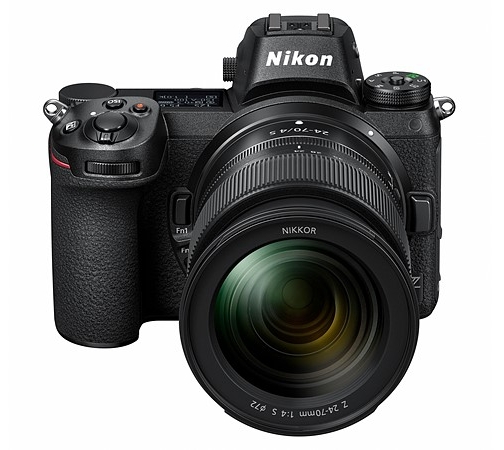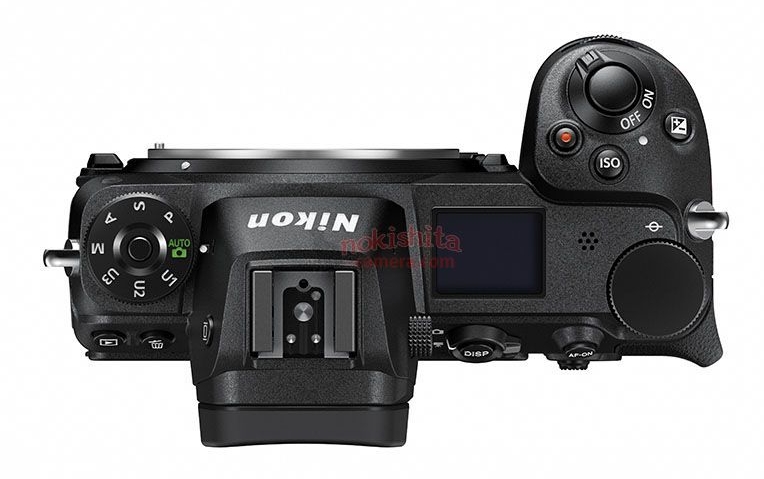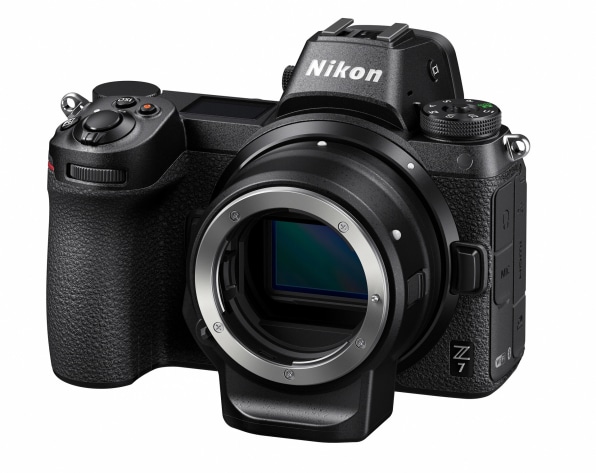
While the little world of Macfilos has been concerned with two new and very relevant cameras — the Leica M10-P and the Panasonic Lumix LX100 Mark II — the wider universe has been focused almost entirely on Nikon. Late to the party or not, the arrival of the new Zeds (or Zees if you live in the USA)¹ is an event of major importance.
With Canon expected to follow suit in entering the mirrorless market in 2019, the new genre, which arrived only in 2008, is set for eventual supremacy. The DSLR will continue for some years, I believe, but gradually the many advantages of digital viewing will win through.
Yesterday I rather jokingly suggested that Nikon had slavishly copied the Sony a7 range, and there are indeed many similarities in appearance and in the adoption of 24MP and 42MP sensors to differentiate the two main cameras. Without a doubt, Nikon will follow with variations, as Sony has done successfully with the a7S, for instance.
Fierce competition

But from today the photographic world will never be the same. We can expect fierce competition between Sony and, first, Nikon, then Canon. Some commentators have suggested that the Zeds outgun the Sonys on autofocus speed and other technicalities, but Sony will fight back and within months will have leapfrogged to even higher goals. This has got to be good, some strong competition for Sony at last. One thing is certain, Sont will not lie on its back and let Nikon tickle it’s tummy.
With sensor technology having reached a point where, for most people, future improvements in image quality will be pretty academic, we now have a staggeringly competent range of alternative homes for our money. Yesterday the mirrorless players were Fuji, Panasonic, Olympus and Sony — with Leica hovering expensively in the background. But now one of the big two professional manufacturers is upping the ante and providing even more incentive for future development.
Below: A good overview of the new Zees/Zeds. I take an instant dislike to the arrogant Nikon representative who insists the camera be called the Nyekon Zee throughout the world. Good luck with that. It reminds me of the hoary old story of the marching soldiers watched by doting parents: “Look, everyone is out of step except our Johnny”. Full marks to Chis Niccolls for holding his own from his Canadian perspective.
If my memory services me, Nikon is now the third manufacturer to enter the full-frame sector, after Sony and Leica. And 35mm sensors, once so expensive, have now become mainstream. At the same time, Sony has shown that the bodies need not be huge (Leica SL huge, for instance), but can be similar in size to APS-C or, even, m4/3 bodies. It is telling that the Panasonic G9 is very similar in size to both the Sonys and the new Nikons.
Of course, lens technology is the big issue here. Full-frame means bigger, heavier professional housings. It’s where m4/3 wins out every time, despite the increasing girth of the camera bodies.
The little and the large

The mirrorless world is now settling down into five sensor sizes, one-inch, m4/3, APS-C, so-called full-frame and medium format. Smaller sensors are virtually dead, victims of the smartphone. While MF remains rather bulky for general use (despite Hasselblad’s admirable efforts at miniaturisation), the big battle lies between m4/3, APS-C and full-frame. Something has to be squeezed. The one-inch sensor is now providing one of the best solutions for travel because of the small body size and correspondingly large zoom possibilities (see the Leica C-Lux and Sony RX100 VI). And full-frame is developing nicely. It will continue to win market share now that Sony has some real competition.
That leaves us with m4/3 and APS-C currently occupying the middle ground. It is anybody’s guess which way consumers will jump in this segment of the market. Fuji fans, in particular, will explain that APS-C offers the very best compromise — almost up there with full-frame in IQ and enjoying lighter and smaller lenses than is possible with full-frame. On the other hand, Olympus and Panasonic addicts can claim that the modern Lumix or OM-D is capable of producing professional results in a system that, overall, is the lightest. The smaller sensor also excels in video and autofocus capabilities. It is also a system which benefits from a massive range of native and third-party lenses.
The APS-C format is hugely popular, especially in the DSLR world where tourists everywhere have basic Nikons or Canons with kit lenses slung around their necks. Most of them have the 18-55mm standard zoom permanently attached to the camera and many, I suspect, do not realise that it can be removed — still less replaced with a fast prime. This market is ripe for the plucking by Olympus and Panasonic. I feel sure most people who opt for the entry-level DSLRs would be better served by micro four-thirds.
As the focus moves away from DSLRs, whether full or crop frame, the spotlight is certainly going to move to the more modern mirrorless cameras with their WYSIWYG electronic viewfinders.
What’s in a name?
What is clear, is that after ten years mirrorless is now a mature market. It has still to conquer the professional world where DSLRs rule supreme for the moment, but Nikon is leading the way to a gradual change. It is going to be an exciting second decade for the non-SL camera market. Perhaps, at this stage (as William Fagan suggests in a comment to yesterday’s Nikon article) we should stop talking about mirrorless. We need a new name. Mirrorless has a slightly negative connotation, as though it is somehow second best by not having a mirror. I suggest we should now talk simply about digital cameras, for the new crop are indeed just that — digital through and through. It’s the DSLR that’s the odd one out in being only half digital. Maybe “digital camera” and “mirror camera” would be a more accurate description.
¹ On the subject of nomenclature, Nikon has succeeded in introducing a new system which will be pronounced entirely differently depending on where you live. In the USA we will be talking about the Nikon Zee while in Britain and much of the rest of the world, our new camera will be the Neekon Zed.
Images courtesy of Nikon
___________
- Subscribe to Macfilos for free updates on articles as they are published
- Want to comment on this article but having problems?

I am with you on the Zee/Zed issue. It might reflect the fact that the US is a bigger market, but it does not make sense to annoy potential customers needlessly. I will ask the ‘Nikon Ambassador’ who will be at my Nikon dealer in Dublin on Friday of next week to convey this to his ‘Government in Japan’.
On the ‘mirrorless’ issue, it does not make sense to describe something by a term which refers to what it isn’t, when there is another term which describes exactly what it is. The term ‘single lens reflex’ (SLR) has been in use for at least 60 years. This describes the camera’s viewfinder system and the obvious future proof electronic version of this term is an ‘electronic viewfinder’ or EVF camera. I never recall anyone describing an SLR camera as a mirror camera in the past. I find a lot of the discussion on digital photography involves inventing new terms for things that are already described by perfectly good and understandable existing terms. Examples would be ‘file’ for photo or image and ‘analogue’ for a film camera or film photography.
The new Nikon cameras are interesting enough for me to take a look at them next week. My main camera system today is Leica M, but I do use Fujifilm cameras for photography for which a Leica M is not suited. My comparison will, therefore, be between Fujifilm and Nikon. I might add that I still have some very nice Nikon lenses from the past which might work well with an adapter, but I usually find that cameras work best with ‘native lenses’. Hence, the new mount is of interest to me. I know very little about Sony cameras other than that my local camera dealer sells a lot of them.
William
A very eurodite article. I am happy to see Sony getting some real ff competition as when I had a Sony system I felt pricing was high but there was no real competition. As I have said before, I think the eventual major future success will be M43 and full frame as APS-C does not offer a major value in reduction in glass size compared to M43 and is too close to Full frame in competition. Hence, I voted with my wallet and went for M43 for most of my glass range and now the Hasselblad X1d for ultimate quality with 3 lenses: 30mm, 45mm, and 90mm. I love the way the X1d interface and handling just gets out of the way like my Leica SL did. I never really got on with the Sony ergonomics and menus in particular but they did have some wonderful glass. I have managed to work with my Panasonic G9 well after configuring the camera and like the size of the body as a camera body can get too small for general use and stability. I think I have found my personal set up for the foreseeable future after much struggle with various systems.
I suspect you are right about the squeezing of APS-C. There are basically three players in the market — Sony, Fuji and Leica — and Fuji is by far the biggest proponent simply because, excluding their MF camera, they have nothing else. Sony is clearly concentrating on FF and the a6xxx range is seen as second best. And I’m not sure where Leica is going with APS-C. Indeed, if it weren’t for my loyalty and my liking for the CL as a package, I would be quite happy with a combination of m4/3 and FF, with a one-inch point and shoot in my pocket for when I don’t want to carry a bigger camera.
What’s in a name: Because we Canadians have always believed in the power of compromise (and just as much because we love to be different) we will call it the Nikon Zed.
As I am sure we will in the UK….. Even Nikon in the UK calls in Neekon and not Neyekon. So I suppose they will say Zed, despite the strident views of the US Nikon marketing people. I wonder what the Japanese say?
"Nikon finally accepts that mirrorless is here to stay" <== this title is of very little good faith and inflammatory. You should be a journalist: "Let’s try to rub it in where we hope it might hurt the most, it will be more fun". It doesn’t make me want to read on, but it does make me want to comment to ask where did you ever read that Nikon used to think that mirrorless was not here to stay? Personally, I have never read any such statement, which would have been ludicrous. It’s like you were saying, "Gosh, Nikon, you guys were wrong and blindfolded for so long, and never wanted to listen to us the learned and wise, we’re glad you have begun to see the true path at last…"
Maybe a touch of modesty would serve. The people at Nikon know better than you what they have to do, and don’t need anyone to tell them, I’m sure.
I wish people would learn to remain factual, that would give us a nice rest from all the hype of fake news.
I am or was, a journalist and perhaps that excuses the inflammatory headline. However, it was not intended to be such. I think you have misconstrued my views on Nikon and the Z6 and Z7. I am excited by the prospect of handling these new cameras and I think it is a very good thing that Nikon has entered the mirrorless market in a big way. But there is no doubt that Nikon has been very late to the party and, I suspect, initially hoped that mirrorless would be a flash in the pan. But Sony has owned full-frame mirrorless for the past few years and that is not a good thing. Competition from Nikon and, in 2019 from Canon, will put new life into the market and that will benefit everyone.
Dominique, one of the reasons I and I suspect many others read Macfilos is that it has a civilised and polite tone without the trolling and unpleasantness which occurs elsewhere. Also most readers and contributors realise that the blog is only about cameras and related -not weighty matters of the world -and hence we don’t really take it all that seriously.
Mike, who runs/edits and writes the blog does it out of love with no financial reward. If he offends you take some deep breaths or a chill pill and cut him some slack or just double click and move onto another blog.